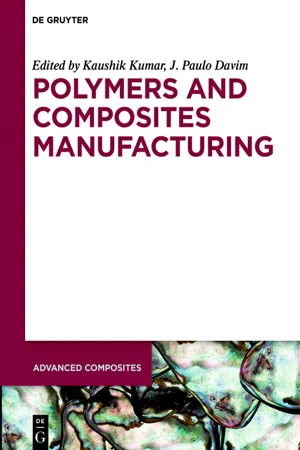
eBook - ePub
Polymers and Composites Manufacturing
This is a test
- 204 pages
- English
- ePUB (mobile friendly)
- Available on iOS & Android
eBook - ePub
Polymers and Composites Manufacturing
Book details
Book preview
Table of contents
Citations
About This Book
This volume reviews a wide range of processing methods which are currently being used for plastics and composites. Special focus lies on advancements in automation, in development of machines and new software for modeling, new materials for ease in manufacturing and strategies to increase productivity.
Frequently asked questions
At the moment all of our mobile-responsive ePub books are available to download via the app. Most of our PDFs are also available to download and we're working on making the final remaining ones downloadable now. Learn more here.
Both plans give you full access to the library and all of Perlego’s features. The only differences are the price and subscription period: With the annual plan you’ll save around 30% compared to 12 months on the monthly plan.
We are an online textbook subscription service, where you can get access to an entire online library for less than the price of a single book per month. With over 1 million books across 1000+ topics, we’ve got you covered! Learn more here.
Look out for the read-aloud symbol on your next book to see if you can listen to it. The read-aloud tool reads text aloud for you, highlighting the text as it is being read. You can pause it, speed it up and slow it down. Learn more here.
Yes, you can access Polymers and Composites Manufacturing by Kaushik Kumar, J. Paulo Davim, Kaushik Kumar, J. Paulo Davim in PDF and/or ePUB format, as well as other popular books in Physical Sciences & Physics. We have over one million books available in our catalogue for you to explore.
Information
Section I: Composite and Mold Design
1 Design, optimization and manufacturing of monocomposite carbon/epoxy leaf spring having varying cross sections
Sushant P. Mhatugade
Department of Mechanical Engineering, MIT, Pune, India
Ganesh M. Kakandikar
Department of Mechanical Engineering, MIT, Pune, India
Omkar K. Kulkarni
Department of Mechanical Engineering, MIT, Pune, India
V.M. Nandedkar
Department of Production Engineering, SGGS, Nanded, India
Abstract
The main objective for weight optimization is to replace a steel leaf spring of a light commercial vehicle with a monocomposite leaf spring. Steel leaf spring is modeled in Creo Parametric with the existing dimensions and analyzed for stress and deflection using ANSYS. A composite leaf spring with varying cross sections is designed by using specifications of a steel leaf spring and optimized by using ANSYS. An optimized composite leaf spring is manufactured by the hand layup method with hot molding process. There was 88% weight reduction for composite leaf spring with varying cross sections, which was the main purpose of this chapter. Fabricated leaf spring is tested for the experimental validation. Experimental values were nearly the same as that of analytical with the negligible error.
Keywords: Optimization, composites, leaf spring, ANSYS, manufacturing, monocomposite carbon, epoxy, design, Creo Parametric, nanocomposites, FRP, finite element analysis,
1.1 Introduction
As composites, innovation progressed in the course of the most recent couple of decades, the constituent materials, especially the reinforced materials, relentlessly decreased in size. Most as of late, there has been extensive enthusiasm for nanocomposites having nanometer-sized reinforcements, for example, carbon nanoparticles, nanofibers and nanotubes, as a result of the uncommon properties of these materials. There is relentless increment in the significance of polymers, composites and ceramics with the diminishing part of metals. Fibrous reinforcement is extremely powerful in light of the fact that numerous materials are considerably stronger and stiffer in fiber frame than they are in mass shape.
Composite applications in commercial aircraft have been steadily increasing as material costs come down, as design and manufacturing technology evolves and as the experience with composites in aircraft continues to build. As an excellent example of innovative design made possible by composites, the use of composites in this airplane resulted in enough weight savings to accommodate the extra weight of an airframe parachute system for safe descent of the entire aircraft in the event of a loss of engine power. The application of composites in commercial airliners has shown steady, conservative growth, but based on the increased prices of fuels, demands by airlines for more efficient aircraft and other recent trends, this growth promises to be rapid in the future.
Focal points of composites over steel are light weight, higher strength-to-weight proportion (up to five times that of steel), no interleaf friction, prevalent fatigue strength, great erosion resistance and higher natural frequency. Composite materials are utilized broadly nowadays in the car business to supplant the metal parts. Springs are crucial suspension components on autos, which are important to limit the vertical vibrations, effects and knocks because of street abnormalities and make an agreeable ride. A leaf spring, notably the longitudinal type, could be a reliable and chronic part in automotive suspension frameworks. These springs are unremarkably formed by stacking leaves of steel, in incessantly longer lengths over one another, with the goal that the spring is thick within the center t...
Table of contents
- Title Page
- Copyright
- Contents
- Preface
- Editors’ Biography
- Section I: Composite and Mold Design
- Section II: Characterization and Properties
- Section III: Simulation and Experimentation
- Section IV: Optimization
- Section V: Environmental Issues
- Index